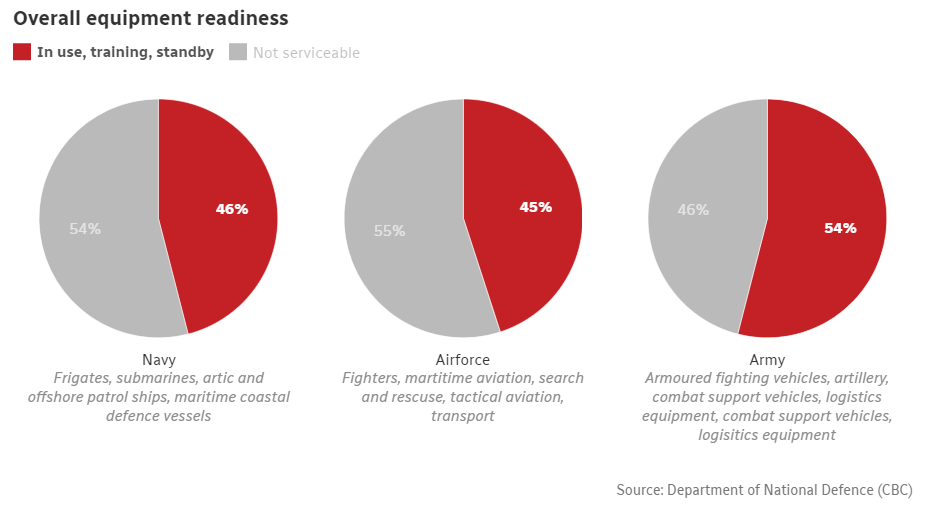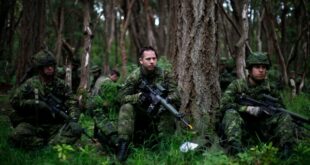Department of National Defence report also says almost half of military’s equipment is ‘unserviceable.’

Only 58 per cent of the Canadian Armed Forces (CAF) would be able to respond if called upon in a crisis by NATO allies right now — and almost half of the military’s equipment is considered “unavailable and unserviceable” — says a recent internal Department of National Defence (DND) presentation obtained by CBC News.
The presentation, which touches on everything from readiness and equipment to recruiting and ammunition supplies, is dated Dec. 31, 2023.
It’s the latest comprehensive snapshot of the state of the military.
The overview paints an alarming picture of the forces’ decline in readiness — one that’s even worse than the figures presented in last year’s federal budget documents.
“In an increasingly dangerous world, where demand for the CAF is increasing, our readiness is decreasing,” says the document.
The issue of military readiness has preoccupied the House of Commons defence committee. The committee held a series of closed-door meetings last year where MPs could discuss sensitive information with top military commanders.
A handful of new public opinion surveys published Tuesday suggest the number of Canadians concerned about military preparedness and the country’s presence on the world stage is growing. One of the polls, by the Angus Reid Institute, found 29 per cent of Canadians surveyed listed those two issues as their top political priorities — a substantial jump from the 12 per cent recorded a decade ago.
That same survey found support for Canada meeting NATO’s military spending benchmark for member countries — two per cent of the gross domestic product — stands at 53 per cent. Support for hitting the two per cent goal jumps to 65 per cent when poll respondents are asked about the prospect of a second Donald Trump presidency in the U.S.
The internal DND presentation shows that only 58 per cent of “committed CAF force elements ready to meet NATO notice move” could respond to the call in the event of major hostilities.
Canada is obliged to commit certain army, navy and air force units to the defence of Europe in an emergency — units that would reinforce troops already in the field, such as the Canadian-led brigade in Latvia.
The presentation shows 45 per cent of the Canadian military’s equipment set aside for the defence of Europe faces “challenges” and is considered “unavailable and unserviceable.”
Not enough people, not enough ammo
The presentation says the air force is currently in the worst shape of all the CAF forces, with 55 per cent of “fighters, maritime aviation, search and rescue, tactical aviation, trainers and transport” considered “unserviceable.”
The navy is not too far behind, with 54 per cent of its “frigates, submarines, Arctic Offshore Patrol Ships and defence vessels” in no state to deploy, the presentation warns.
The army fares slightly better, with only 46 per cent of its equipment considered “unserviceable.”
The biggest challenge, according to the presentation, is “people shortfalls — technicians and support” as well as “funding shortfalls — spare parts and ammo.”

At the end of last year, the document says, the military was short 15,780 members, a figure encompassing both regular and reserve elements.
The federal government recently began reallocating funding, forcing some areas of DND to cut spending in order to pay for the acquisition of new equipment. The latest federal estimates for the upcoming year show $810 million will be shuffled around — and $79 million of that money is coming out of “ready forces.”
CBC News shared a copy of the internal report with former vice-admiral Mark Norman, a former commander of the navy. He said he was startled by the numbers.
“This is borderline atrocious,” Norman said.
“Readiness is all about measuring the ability of your armed forces to do what it is they’re expected to do. And fundamentally, that’s all about going somewhere and fighting. And, you know, it’s a pretty dire situation when you’re … not where you need to be.”
Kerry Buck, a career diplomat and Canada’s former ambassador to NATO, said she was “shocked but not surprised” by the numbers.
“It means that Canada’s falling further down the rank of allies. It means that the gap is growing between our international commitments and our capacity,” Buck said. “It impacts our credibility at NATO for sure, but it impacts our security interests, too. It’s in our security interest to be a credible contributor to NATO.”
She said the presentation “should set off alarm bells.”
Eighteen months ago, in response to Russia’s full-scale invasion of Ukraine, NATO agreed to keep more troops in a higher state of readiness. The alliance pledged to have 300,000 soldiers, sailors and aircrew across the entire 31 (soon to be 32) member nations of the alliance ready in case of major hostilities.
While a number of analysts have questioned how tangible that promise is, NATO’s expectation is that each country meets its designated contributions.

Under NATO’s pre-2022 readiness plan, Canada was obliged to keep 3,400 members of its Armed Forces at a high state of readiness.
The federal government has yet to announce how those NATO member pledges will affect the size of Canada’s high-readiness contingent. Buck said Canada almost certainly will be called upon to boost the contingent’s size, since the 300,000 figure represents an eight-fold increase in the size of NATO’s high-alert force.
In a year-end interview held last December — before CBC News obtained a copy of the internal assessment — Vice-Admiral Bob Auchterlonie, the head of the military’s joint operations command, was asked about NATO’s readiness requirements.
Was he comfortable that Canada could meet the expectations?
“Comfortable today? Probably not,” Auchterlonie replied. “Not today, given the shortages we have in different organizations. Could you generate [forces] that quickly? Probably not.”
He said he’s confident that the revised national defence policy — still being worked on by the federal government — will include a “plan … to have those capabilities available in a few years.”
Older equipment costs more to maintain
Auchterlonie also pointed out that a call-up from NATO wouldn’t mean that Canada has to deliver all its capabilities and reinforcements in one shot.
“It’s in buckets of, you know, [forces dispatched] within 30 days, 90 days, 180 days,” he said.
One of the biggest challenges, Auchterlonie said, is the age and “fragility” of some major pieces of equipment, such as frigates and jet fighters.
“The amount of maintenance required to keep old stuff going has an operational impact,” he said.
While visiting Edmonton on Monday, Defence Minister Bill Blair was asked how he assessed the state of readiness in the military. “We’ve got some work to do,” he replied.
He spoke about CAF’s recruiting challenges and how DND has tried to recruit permanent residents into the ranks. The Liberal government opened the recruitment door to newly arrived Canadians more than a year ago to help fill out the ranks.
A recent CBC News story said that while more than 21,000 permanent residents have applied, as of last month fewer than 100 had been enrolled in the forces and many applications were still stuck in the security vetting process.
Canada finds itself in such a dire situation for several reasons, said Norman.
“It’s been decades in the making,” he said.

Demands on Canadian military increasing as readiness decreases, documents say
CBC News has obtained new leaked documents that reveal just over half of Canadian Armed Forces personnel could deploy if called upon to do so and nearly half of the military’s equipment is considered ‘unavailable and unserviceable.’
The bureaucratic and political culture in Ottawa, he said, defaults to “risk managing” and avoiding problems rather than confronting them.
The approach within DND, he said, has been to assume that things are not that bad and some level of risk can be accepted for a few years.
“This perpetual risk management approach is so dangerous because it pushed off problems until it’s somebody else’s problem,” said Norman.
“Well, guess what? It’s 2024 now and most of those problems are now here and they’re literally kicking us in the face.”
ABOUT THE AUTHOR
Murray Brewster is senior defence writer for CBC News, based in Ottawa. He has covered the Canadian military and foreign policy from Parliament Hill for over a decade. Among other assignments, he spent a total of 15 months on the ground covering the Afghan war for The Canadian Press. Prior to that, he covered defence issues and politics for CP in Nova Scotia for 11 years and was bureau chief for Standard Broadcast News in Ottawa.
*****
Credit belongs to : www.cbc.ca
 Atin Ito First Filipino Community Newspaper in Ontario
Atin Ito First Filipino Community Newspaper in Ontario






